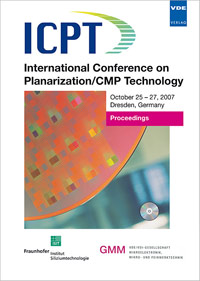Pad Roughness Effects on Removal Rate and Selectivity in a STI Ceria CMP Process
Konferenz: ICPT 2007 - International Conference on Planarization / CMP Technology
25.10.2007 - 27.10.2007 in Dresden, Germany
Tagungsband: ICPT 2007
Seiten: 7Sprache: EnglischTyp: PDF
Persönliche VDE-Mitglieder erhalten auf diesen Artikel 10% Rabatt
Autoren:
Meyer, Frank C.; Rudolph, Catharina; Faustmann, Peter (Qimonda Dresden GmbH & Co. OHG, Dresden 01099, Germany)
Kuo, Chi-Hsiang (Nanya Technology Corporation, Taoyuan 33383, Taiwan, R.O.C.)
Inhalt:
Pad surface effects are known to be one of major impacts on removal rate and polish performance of a chemical mechanical polishing (CMP) process. Especially on direct shallow trench isolation (STI) CMP with cerium oxide (CeO2) slurries, different roughness are yielding different removal rates. In this paper, three conditioners, which are different in diamond size and density, are used to evaluate the polish behaviour in a ceria STI CMP process on silicon oxide (SiO2) and silicon nitride (Si3N4) sheet wafers. 90nm wafers with a high density plasma fill (HDP Fill) are used to prove the transfer of sheet wafer behaviour to structured wafers. Motor current endpoint detection (EPD) has been applied to assess the transient planarization during the polish, due to its ability to display friction changes during polish.


